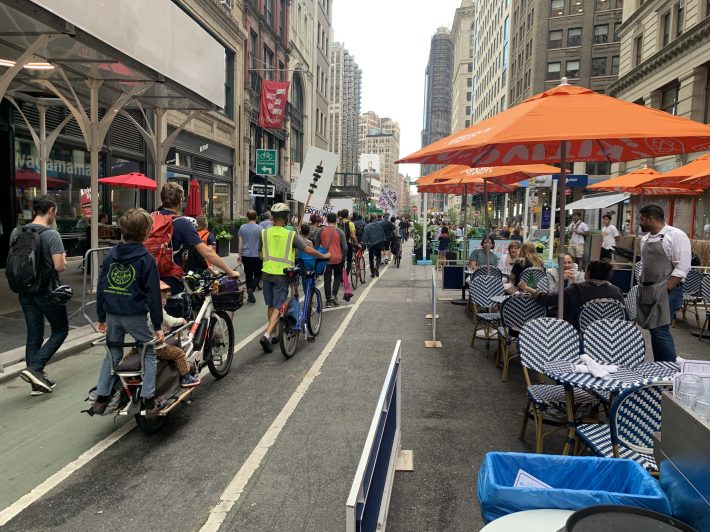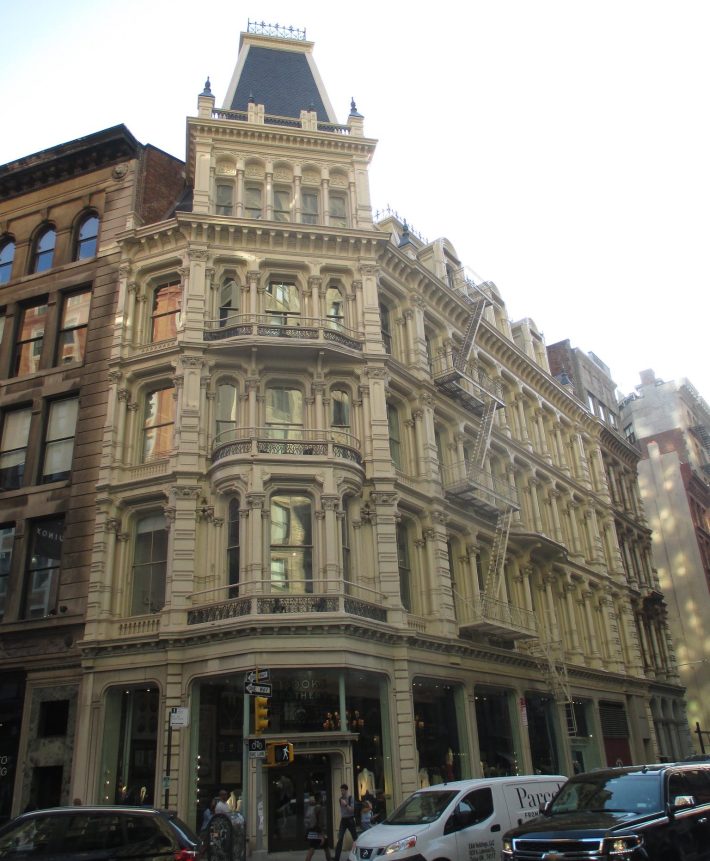The full pedestrianization of Broadway has gained even more influential elected champions.
Earlier this month, Manhattan President Mark Levine and local Council Members Carlina Rivera, Erik Bottcher and Keith Powers wrote to the DOT urging that it immediately declare Broadway from 14th to 34th streets a "limited access open street" and quickly develop a "comprehensive" corridor-wide plan for pedestrianizing it, first on that stretch and later up to 42nd Street.
"Crash statistics back up the need to further limit cars," the electeds wrote. "Between August 2011 and May 2022, 205 pedestrians, 102 cyclists, and 122 vehicle occupants (429 in total) have still been injured along Broadway between 14th and 42nd streets; tragically, four pedestrians have been killed along this stretch" during the period.
"This stretch of Broadway needs to be made safer, and we believe pedestrianization, with limited necessary entries for vehicles that must access certain points along Broadway, could be away to positively transform the area and benefit all New Yorkers," they wrote.
They want to see a tangible plan by fall and concrete actions in the first quarter of 2023; they'd like to see the draft for the final eight blocks by the second half of that year.
Their direct talk is refreshing — and it’s been a long time in coming.
When Mayor Bloomberg's transportation commissioner, Janette Sadik-Khan, first approached business leaders about pedestrianizing Broadway about 20 years ago, hush hush and go slow were the watchwords.
Sadik-Khan didn't speak about pedestrianizing the street, she talked about "de-emphasizing auto traffic in favor of pedestrians" and of doing so on a trial basis "in phases" so that the business and property owners along the boulevard could get used to the idea, recalled Dan Biederman, the president of the 34th Street Partnership, the business improvement district that encompasses the prime Manhattan shopping area. And she cautioned against exercising the press, Biederman said (a warning that proved prophetic when the New York Post successfully marshaled opposition to the pedestrianization of 34th Street).
Over the years, some property owners along Broadway grumbled about aspects of the agreements the Department of Transportation struck with the BIDs in order to pedestrianize certain areas but, by now, commercial interests on Broadway are "enthusiastic" about the end result, Biederman said.
"Very few people would want to go back to four lanes of traffic rushing down Broadway," Biederman said, adding, "Broadway should be closed to traffic from 14th Street to 59th Street. ... It's good for economic development!"

Biederman said that he commends the electeds' approach. He's not alone. The BIDs along Broadway are among the biggest proponents of pedestrianizing the roadway and of hastening the staged approach of Mayor Adams's last two predecessors, which envisioned various “pedestrian-friendly” treatments from Columbus Circle to Union Square under a rubric called "Broadway Vision."
The BIDs should know. The 34th Street Partnership operates "Broadway Boulevard," a pedestrian plaza from 33rd to 35th streets alongside Greeley and Herald squares that it calls "a place of relaxation, rendezvous, and recreation." The Flatiron-Nomad Partnership, which covers an area from 31st to 20th streets, has dominion over a "shared street" on Broadway from 21st to 23.
What Levine and the Council members are proposing, in effect, is that, for safety's sake, the city abandon the staged approach and connect the dots between these areas — stat! — before another motorist injures or kills again.
The pedestrianization of the Great White Way gained impetus last month with an incident that was emphatically not good for business: On June 20, a taxi driver hit a cyclist at Broadway and 29th Street in the Flatiron district and then jumped a crowded curb, injuring six people, including a tourist who lost her leg when she was pinned to a building.
Activists and business leaders promptly called for more pedestrian safety, and the city responded by accelerating long-delayed plans for traffic calming of the stretch of Broadway in question. It said it would establish permanent plazas on the Broadway blocks from 25th to 27th streets and to turn the blocks from 27th to 29th streets into a “shared” street similar to the one from 21st to 23rd streets.
The recent horrific taxi crash on Broadway & 29th makes it clearer than ever: we need dramatic street redesign in this area to prioritize pedestrians.
— Mark D. Levine (@MarkLevineNYC) July 3, 2022
My colleagues and I are calling for Bway from 34th St to Union Sq to immediately become an Open Street.https://t.co/8wsKWdyYzQ
That's a good start, but many people want more: Activists for years have called for Broadway to be pedestrianized from 125th Street down to at least Houston Street in SoHo.

The plan would have the salutary effect of helping New York's former premier shopping district to re-emerge from under the wheels of the automobile.
In the late 19th century, "Ladies' Mile," the area from 15th to 24th streets, sported the city's the first department stores, many housed in buildings with ornate, cast-iron facades that typified the era's exuberant architecture. Designated as a historic district in 1989, Ladies' Mile comprises a discontiguous group of 440 buildings, along the blocks, bordered by Park Avenue South in the East and Sixth Avenue in the west (both of which are car sewers). Broadway, the site of some of those department stores, such as the original Lord & Taylor at 20th Street, cuts diagonally through the heart of it.
The old Ladies' Mile storefronts on Broadway are now occupied by marquee retailers such as Paragon Sporting Goods and ABC Carpet and Home, as well as many restaurants and small businesses. On Sixth Avenue, the historic buildings house huge stores such as Bed, Bath & Beyond, Burlington Coat Factory, The Container Store, and Trader Joe's. It would certainly help those businesses' throngs of shoppers to have a safe, pedestrian space nearby — as well as put New York on-trend with world cities that have made their central shopping districts car-free.
The city, for its part, said that "[t]he administration has laid out a bold two-pronged street safety strategy with immediate and long-term actions the area around [the] crash, and our ‘Broadway Vision’ plan will thoughtfully pedestrianize much of the corridor from Union Square to Columbus Circle," according to DOT spokesman Vin Barone. "We appreciate our colleagues’ focus on this area and look forward to working with them and the community to identify the best ways to achieve our shared goals.”






